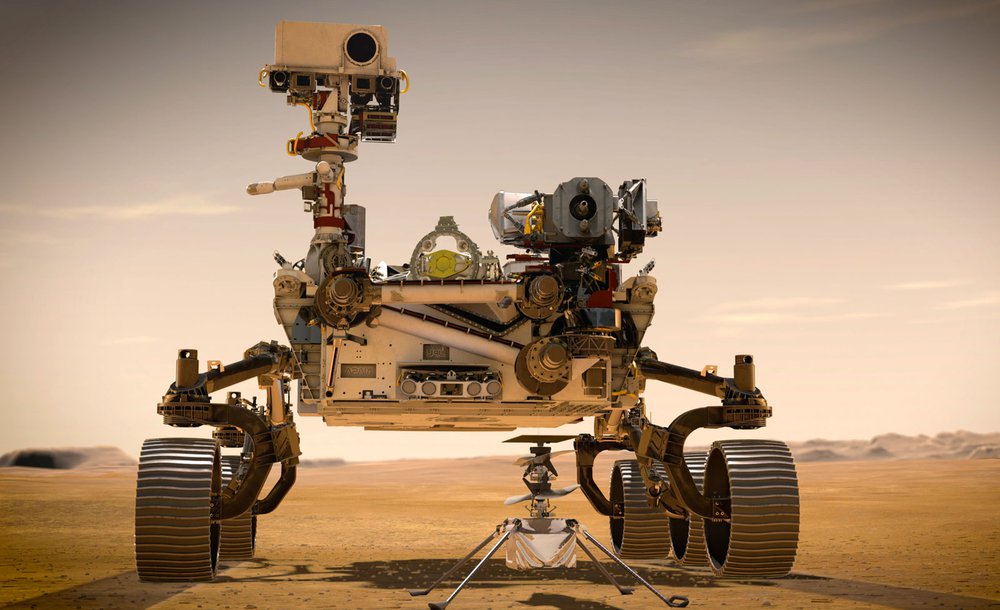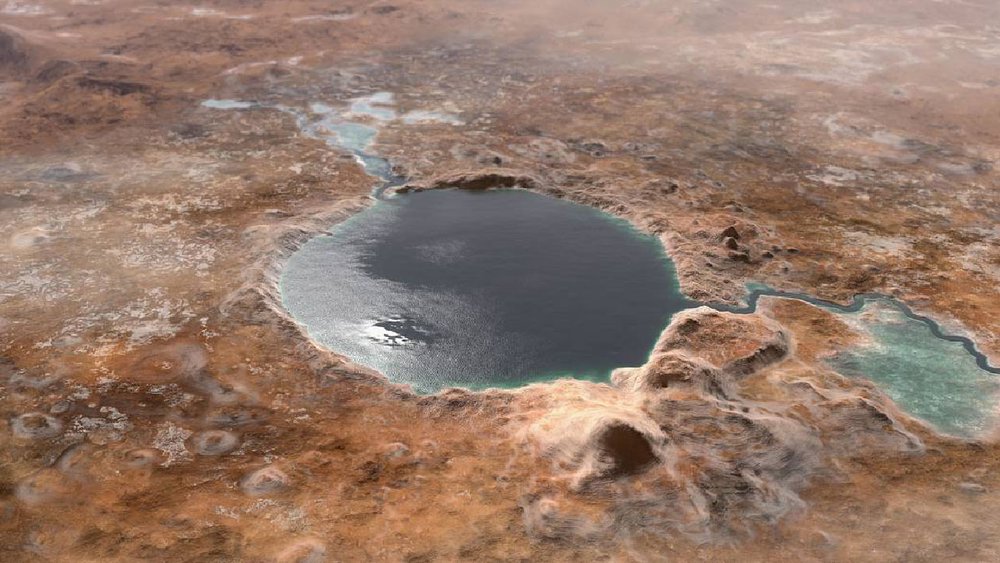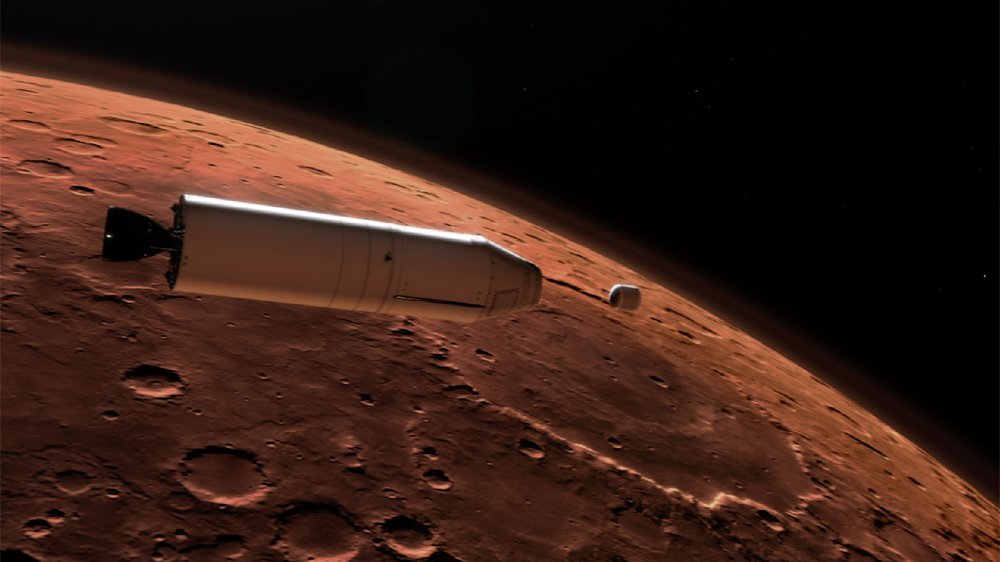
Out in the cold, empty void beyond Earth, NASA's latest Mars mission is hurtling at 43,000 miles per hour toward the Red Planet. The mission, Mars 2020, passed the halfway point of its journey in October 2020 and is expected to touch down on solid ground on February 18.
The mission is the first part of an audacious plan to do something humanity has never done before: Bring a piece of another planet back to Earth. (NASA has retrieved rocks from the Moon, but it is not considered a planet). This plan, known as Mars sample return, will involve three missions spanning a decade.
For Ken Farley, Caltech's W. M. Keck Foundation Professor of Geochemistry and the mission's project scientist, Mars 2020 is the culmination of years of dreaming and careful planning.
"The idea of bringing a sample back from Mars goes back decades," he says. "We are in a position now where if everything goes according to plan, samples will be coming back to Earth in 2031. That sounds like a long time, but this becoming a reality has always been 10 years away since I was in grad school. Now we are actually doing it."
Once the mission arrives safely, it will deploy two vehicles: the Ingenuity helicopter drone and the Perseverance rover. Ingenuity will test our ability to use aircraft on a planet that has an atmosphere less than 1 percent as dense as Earth's. Perseverance will be engaged in a task that offers potentially paradigm-changing rewards: drilling into the rocky surface of Mars to investigate the possibility that life may have once existed there.

The Perseverance rover and the Ingenuity helicopter (foreground) as they might appear on Mars.
Credit: NASA/JPL-Caltech
In many ways, the Perseverance rover is much like the previous rover missions that NASA and JPL, which Caltech manages for NASA, have sent to Mars. It has the same blueprint as its predecessor Curiosity (2012): six wheels, a body, and a collection of sensors. Those earlier rovers, including Opportunity (2004), Spirit (2004) and Sojourner (1997), were designed to take measurements of the planet's atmosphere and surface and broadcast them back to us. Perseverance will prepare rock samples for their return to Earth.
It will do so at the edge of Jezero crater, which is believed to have once contained a lake the size of Lake Tahoe when Mars still had liquid water on its surface billions of years ago. Farley says a key attraction of Jezero is a well-preserved river delta, a geological feature that forms when a river drops large amounts of sediment as it empties into a lake or ocean. On Earth, river deltas are productive places where life flourishes, so the thought is that if life ever developed anywhere on Mars, it may likewise have been plentiful at the Red Planet's own deltas.

An artist's rendering of how Jezero Crater might have looked as a lake when liquid water still existed on Mars.
Credit: NASA/JPL-Caltech
"Jezero would have been a place that was habitable," Farley says. "Life as we know it could have lived in that lake, and the mud of a delta is really good at preserving the biosignatures of life."
When Perseverance arrives at an area that looks promising to the research team, it will obtain a sample with a drill bit that cuts a cylinder-shaped core while drilling the rock. Such cores are valuable to researchers because they provide a cross-sectional view of the layers and other features of the rock. The rover will drill about 40 cores from the ground, each about the size of a stick of chalk, and seal them into sample tubes. At some point, the rover will place them on the Martian surface for later retrieval.
"After we drill them, we do something that seems crazy: We set them on the ground in what we call a cache," Farley says. "In the next two parts of the mission, we go get them and bring them back."

A rendering of the Sample Return Lander's rover approaching core samples left by the Perseverance rover. Its mission has not yet been approved by NASA.
Credit: NASA/JPL-Caltech
The second stage of the mission is the Sample Return Lander. The current plan, which has not yet been formally approved by NASA and Congress, calls for the lander to deliver both another rover and a rocket on Mars following launch in 2026 or 2028. That rover will retrieve the cache of cores left by Perseverance and place them in the rocket, called the Mars Ascent Vehicle. With the cores in place, the rocket will launch from the surface and place a basketball-sized container holding the samples in an orbit around Mars.

If approved, the Mars Ascent Vehicle will launch a container of samples taken from the surface of Mars into an orbit around the planet. A later mission is planned to retrieve them and return them to Earth.
Credit: NASA/JPL-Caltech
While NASA is prepping the Sample Return Lander, the European Space Agency will be putting together its own mission that will handle the last step of sample return. This craft will make the same long trek to the Red Planet, but when it arrives, it will not land. Instead, it will retrieve the orbiting cache of rock samples and head back to Earth with them, with a planned arrival in 2031.
It is a long timeline; Mars 2020 development started in 2013, and the planetary samples will not be returned until 18 years later. But, Farley says, there are good reasons to do it that way.
"It's just too complicated to send it all at once," he says. "And it makes a lot of sense to spread it out over multiple years so the amount of money you need in one year is not too much. Also, you need a lot of talent to invent and build the new things each piece of this mission needs. By developing them over an extended period, we can have enough engineers for that."
What are the benefits of bringing Martian rocks back to Earth?
For one, because the life-forms that existed on Earth 3.5 billion years ago were far more primitive than today, there are no fossil bones to find. At most, there would have been microbes, the telltale signs of which are much harder to confidently identify than a piece of a dinosaur. Very sensitive instruments are required to identify those signs of life-equipment that is simply too big and heavy to put on a rocket and launch into space.
"Some of the instruments we'll use for testing are as big as a car," Farley says. "You just can't fly something like that, so if we are ever going to obtain a quantitative history of Mars and clear evidence for potential Martian life, we have to bring samples back. And the burden of proof for saying there was life on Mars is very high. You have to be certain, and the best way for us to be certain is to examine these samples in labs back here on Earth."
Despite the fact that Mars is currently too cold and dry for any known form of life to exist there now, for safety purposes the cores will be stored in a secure facility until it can be confirmed that they contain no living Martian organisms.
If everything goes right, and NASA successfully brings samples back, the knowledge we gain about Mars could be immense, Farley says, and could also provide insight into our own origins.
"Life was thriving on this planet 3.5 billion years ago in shallow lakes and seas" he says. "Jezero is a 3.5-billion-year-old shallow lake on Mars, so what's the difference between that lake and the ancient lakes and seas on Earth? Did life exist in Jezero? If you build a habitable environment, does life always appear? Or is there something magic about our planet?"
"The answer to this question is profound," he adds. "The last decade has revealed that the galaxy is filled with billions of planets, and many of those are likely habitable. How many of them did or do harbor life?"






